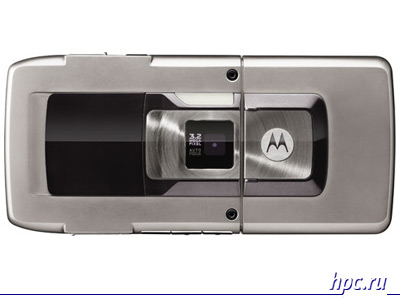Barely managed to finish in Russia to celebrate New Year and begin the orderly celebration of Orthodox Christmas as kicked off the first major exhibition of IT-2008. Completion of CES 2008 coincided with the first working day, making some confusion in the news columns. Now that the show has died down, you can easily make out the material and discuss the sensation. Traditionally, CES is devoted to consumer electronics as a whole and not to fixate solely on mobile topics. Nevertheless, the most impatient manufacturers of mobile devices of varying degrees "umnosti" were not put off their latest in a long box to the profile February Mobile World Congress, reasonably believing that at CES for their development are much more likely not to be lost.
Bright digital future through the eyes of Paul Otellini
One of the highlights of the exhibition along with the swan song of Microsoft founder Bill Gates has become a sensational speech Intel CEO Paul Otellini. Despite the fact that at CES at the head of Intel was enough interesting topics for the introductory speech - at least, the debut of 16-a new family of Penryn - he dedicated it to the concept of mobile Internet - "Internet in your pocket." The basic idea boils down to being able to get any information at any time and anywhere in the world. For example, visiting Beijing, users from around the world will be able through special Web-services institutions to translate signs, menu items catering and even conversations with representatives of the local population. All of this visually or in sound - it does not matter. The main thing - at any time took a small device - and now, all the information the world is on your hands, no brakes, and procrastination.
 |
Towards achieving this ambitious goal Otellini identified four global challenges that lie ahead:
- Mobile devices need to get a sufficiently powerful and yet economical microprocessors;
- infrastructure of wireless broadband networks to be deployed widely enough to ensure universal broadband access to the Internet;
- Internet should acquire a more intelligent search facilities that result does not depend on the case;
- user interfaces must become more comfortable and natural using voice and gestures.
To achieve a brighter future, Otellini took the world by three to five years. At this stage of the IT-industry it does not seem unattainable slogans like "Communism and the 80 th year." In many ways last year, you may have noticed that mobile devices in their current understanding reached the ceiling of development and we are on the verge of breakthroughs that will radically change the world. According to Otellini, this will be the most radical change in the essence of consumer electronics since the invention of television. In addressing the first two problems Intel is actively involved, improving microprocessors and wireless connections. The last two issues are also not gone unnoticed Intel, but the primary responsibility for their decision still rests with the other giants - Google, Apple and many others. In support of the activity was presented to Intel chip Canmore - first product class SOC (system-on-a-chip, system on chip) for consumer electronics. According to the description Canmore combines processor core class personal computer, providing high-speed processing of audio-video supporting resolutions to 1080p and multichannel 7.1 audio, three-dimensional graphics accelerator to work with attractive user interfaces and online games, as well as technology support for broadcast television. He is scheduled for release in the second half of this year. In addition, during the first half of the year will begin delivery devices based on the platform Menlow. It includes a chipset codenamed Poulsbo and Silverthorne processor five times more compact in size and ten times more energy efficient than processors with ultra low power consumption for portable devices, presented by Intel in 2006.As a basis for universal broadband access Otellini agitating in support of the standard WiMAX, which is ready for widespread implementation. It is predicted that by the end of 2008 to be connected to WiMAX networks are already some 150 million users. The concept of MID (mobile internet device, mobile internet device) was first proposed by Intel yet, at the spring IDF in the past year, at the recent CES it was supported by more active and, most importantly, the compelling evidence in the form of working samples of devices. Not forgotten the idea of ultra-mobile PCs - UMPC, the exhibition showed improved and new models in its class. Since there is a clear misunderstanding of the difference between the concepts, Intel recalled the major differences. UMPC - this device is a business-class, working with such "heavy" OS like Vista and optimized for use with office applications such as Excel and Word. MID - a consumer-grade device that works with lightweight operating system, providing quick start, such as Linux. MID is optimized for playback of multimedia content and Web-surfing. Planned for 2009 based devices Moorestown platform will be treated exactly the class of MID. Total has been demonstrated quite a bit of both classes of devices, have attracted the most attention are MID and UMPC: BenQ, and Lenovo introduced its first device-class MID. Device from BenQ has a 4.8-inch display, is based on Menlow and Wi-Fi support with HSDPA. Design does not possess an original, simple and easily recognizable in the Chinese style. MID from Lenovo also based on Menlow, and is equipped with 4.8-inch touch screen. On the technical parameters while virtually nothing is known, however, shows that the device will definitely attract attention. The reason for this interesting design with the original keyboard, located on the side.
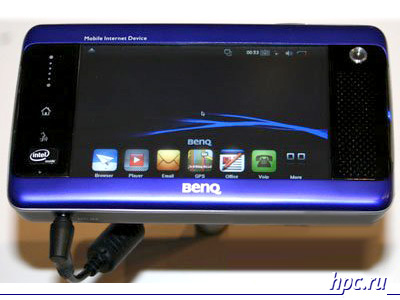 |
| MID from BENQ |
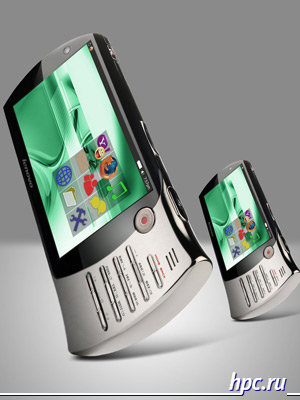 |
| MID from Lenovo |
LG and Toshiba also made its debut with its first UMPC. LG UMPC is made in the familiar form factor of a horizontal slider with a sliding QWERTY-keyboard. The main highlight in the increased compactness - the display device has a diagonal of 4.8 inches and weight is placed in 590 grams. Toshiba model is still at the concept stage, but is in itself interest both in terms of both design and in features. Navigation buttons are made under the 5.6-inch display, the solution is quite controversial and unusual. For large screen size than the LG UMPC, Toshiba UMPC weighs considerably less - only 410 grams. Such a result is reached, probably mainly due to the lack of keyboard and the use of SSD-drives instead of Winchester. Both UMPC based on Menlow platform and running Windows Vista.
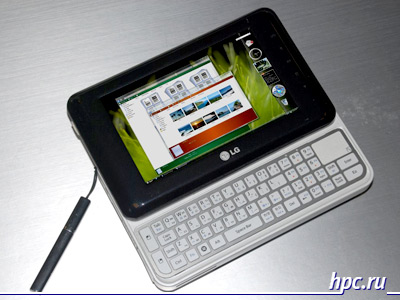 |
| LG UMPC |
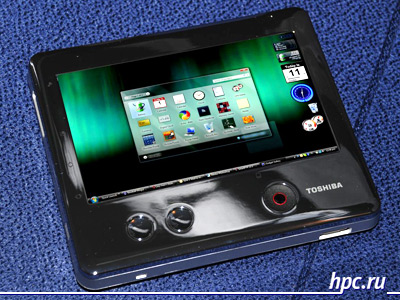 |
| Toshiba MID |
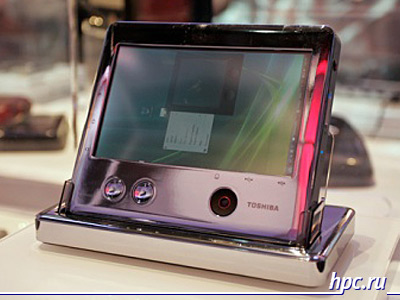 |
| UMPC Toshiba |
Also on display were presented new versions of already known models of ultra-mobile PCs. Q1 Ultra Premium Samsung's become much more productive with the new processor Intel Core Solo U1500 ULV, but it has not lost in such parameters as battery life, which can now reach 7.5 hours, almost twice longer than its predecessor. Model OQO O2 has got the option SSD-drive capacity of 64 GB and support for standard mobile WiMAX.
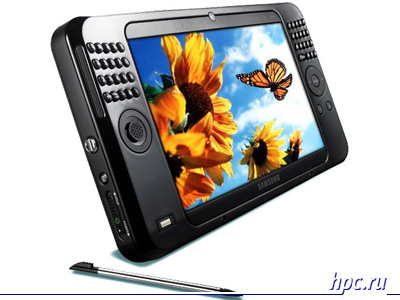 |
| Samsung Q1 Ultra Premium |
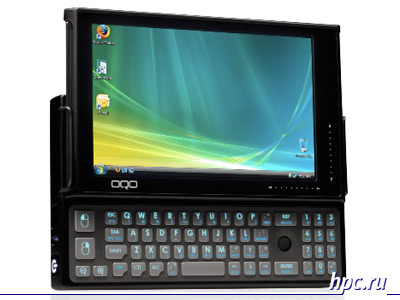 |
| OQO O2 |
Journalists Engadget managed to get a prototype of the very "iPhone Clone from Intel" and made him a little photo shoot. Recall that this is a Class MID actually resembles a cult iPhone lack of control buttons and a display of the entire front portion. It is interesting that according to the author Engadget, the device is built on the platform Menlow, instead of Moorestown, as previously assumed. If this is true, then the device based on this prototype could be on sale earlier than expected, but there will be less attractive in terms of energy efficiency and other indicators.
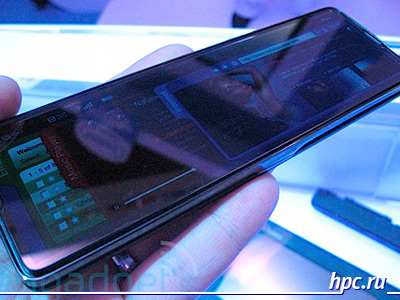 |
| prototype Intel |
Classics of the genre and new trends
Among the classic smart phones, communicators and PDAs have also been shown many interesting things. Motorola has finally been formally introduced a smartphone index Z10, rumors of which wandered for several months. This was indeed the heir to "media monster" Motorola MOTORIZR Z8, which was released last year. New inherited a slider, curving to the shape of the cheeks during the opening, as well as one of the main features - the lack of touch screen despite the work of running Symbian UIQ. In the Motorola Z10 multimedia producer increased focus by improving its ability to shoot photos and video. First, the resolution of the camera is now 3.2 megapixel vs. 2 megapixel earlier, and secondly, the camera became a rate of fire. As a result, the novelty is positioned as a mobile studio. User Z10 can take up to 3 pictures per second at full resolution, and video - at a rate of 30 frames per second.For a complete sense of self as an experienced user video creator software installed, you can edit clips, create transitions between scenes, titles, images and even add a soundtrack. Given the emphasis on large amounts of "heavy" content in the smartphone incorporated support for memory cards with an eye to the future - micro-SD up to 32GB. While in the sale, and then for some diligence, you can find the 8GB micro-SD card. Motorola Z10 smartphone definitely hints to future users - removed a lot of stock and not worry about that stuff would not fit in memory. It is significant that Motorola did not try to catch up with the megapixel race participants, apparently realizing the hopelessness and futility venture at this time. The concept of a smartphone Z10 looks pretty exciting and it could help to ease the American manufacturer of the protracted crisis.
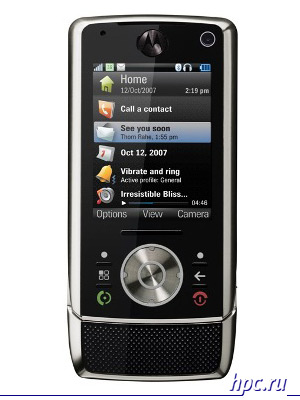 |
| Motorola Z10 |
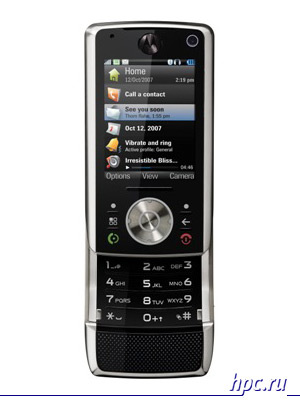 |
| Motorola Z10 |
Not too well known to consumers a simple company Wistron, which specializes in ODM-contracts, could produce a sensation. But little did not have time, and the sensation was held until only the company said. Smartphone marking GW4 could be, but until he became the first true "guglofonov. Demonstrated at the show specimen was running far less romantic MontaVista Linux 2.6, and from this has lost the lion's share of charm, becoming just another piece with a QWERTY-keyboard oriented horizontally display and boring performance characteristics. If you believe the developers, then in March of this intermediate product would be a finished product running on a platform of Google Android. According to forecasts of most Google, the first device based on Android will appear in the second half of 2008, so that Wistron still have a chance to become a winner in the race. Under what brand of smart phone will go on sale is not yet known, she Wistron vague hints at the world-famous brands.
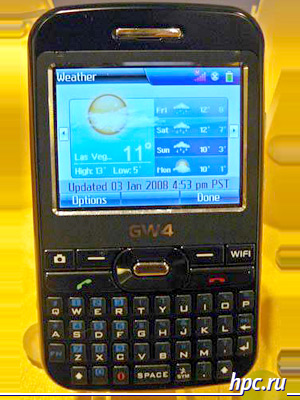 |
| Wistron GW4 |
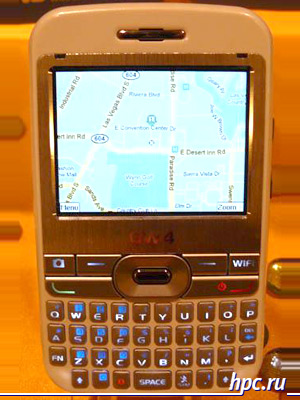 |
| Wistron GW4 |
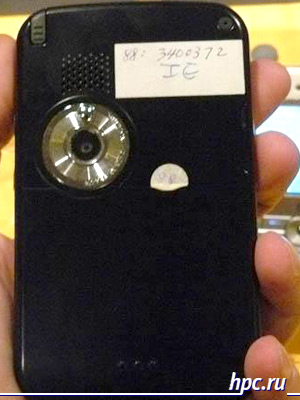 |
| Wistron GW4 |
Another debut, this time to the present, was held for the operating system from the company Soleus Intrinsyc. The famous producer of computer components MSI introduced the first phone based on the OS. Model called the MSI 5608 is designed for GSM networks and supports the GPS-navigation.Zest phone is the new platform, the touch-based gestures, interface. As can be seen in the photo, the menu is arranged in a piktogrammok located wheel that can scroll with your finger. Recall that the Soleus platform was developed as an alternative to Windows Mobile and is built on the core Windows CE. The first installment MSI 5608 will soon appear on the Asian markets, and subsequently scheduled for release in Europe and America. It is worth noting that the manufacturer is considering the release of this smartphone with support for the WiMAX standard later this year.
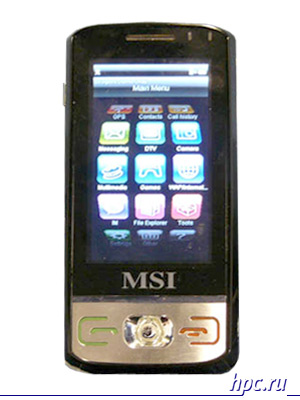 |
| Phone MSI 5608 on OS Soleus |
Manufacturer Qualcomm has decided to prove that the Snapdragon chipset actually exists in the real universe, showing prototypes Fairbanks and Anchorage. Model Fairbanks - it's just multi-media player with navigation capabilities, and Anchorage is a communicator with the QWERTY-keyboard. Demonstration sample Anchorage is powered by Windows Mobile 5.0, but it is not an indicator, since the mass production of devices Snapdragon is scheduled for late 2008 - early 2009, and by the time you may receive the new generation OS. Recall that in the Snapdragon part of the processor with 1 GHz, a cell module for third-generation networks, controllers, Bluetooth and Wi-Fi.
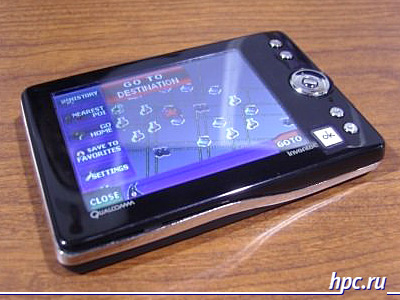 |
| Qualcomm Fairbanks |
With these prototypes came out pretty complicated story, which was originally eyewitnesses described the exhibition as their models based on Snapdragon, it is obvious that they are remembered by the readers of news around the world that way. However, the closing day of CES resource Engadget has published the news under the headline: "This is no joke: Snapdragon-prototypes do not use the Qualcomm Snapdragon". As explained in the article, the editors asked the representatives of Qualcomm asking slightly adjust the original news. Supposedly prototypes represent "an example of opportunities to be enjoyed Snapdragon-device", but it uses a different chipset. It remains unclear how the current chipset can show the same features, which will advertised Snapdragon, but leave it on the conscience of PR-managers Qualcomm.
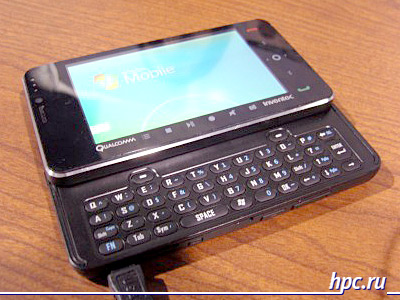 |
| Qualcomm Anchorage |
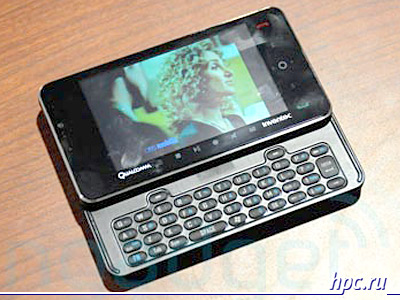 |
History of Internet Communicator Sony mylo will be continued. Over the past since the release of the first mylo concept of "My Life Online" has increased markedly, resulting in a toy for young people, loving communication via IM, began to turn into a multifunction device with good potential. The second-generation mylo has got a touch screen is much larger than before, the size and resolution. At 3.5-inch screen with a resolution of WVGA (800 x 480 pixels) can already be relatively comfortable viewing Internet sites, the difference is noticeable after the 2.4-inch QVGA-display. In addition, there was a built-in camera, support not only the 802.11 b, and 802.11 g, backlight on the keyboard, and plus the reduced price. At the time of the announcement of Sony mylo's recommended price was $ 350, while Sony mylo 2 - for 300 dollars.The company pretty well taken care of software and then work with widgets, email, RSS, client installed popular IM clients AOL, Yahoo!, Google and Skype, Web-Browser Netfront with Adobe Flash Lite 3, which is designed to work with Flash-oriented sites media player and other pleasures of life. From minus-one Sony mylo 2 can be noted preserved the lack of support the Bluetooth interface and the problems with the installation of third-party software.
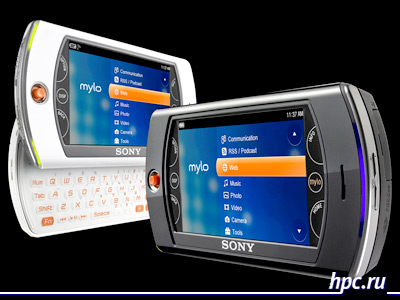 |
| Sony mylo |
An unusual series of devices LimePC the Chinese Tsinghua Tongfang once again showed how illusory is gradually becoming a distinction between classes of "mobile computer" and "Pocket PC". The series includes three raznogabaritnyh device with almost identical features. All of them are built on the mobileGT from Freescale, supports Wi-Fi, Bluetooth 2.0 + EDR and equipped with a touchscreen. The main difference in size and used drives: the LimePC UMPC uses the hard drive from 30GB to 100GB capacity, while LimePC HandheldPC and LimePC PalmPC - 8 or 16GB of flash memory. LimeOS operating system based on Debian Linux. The smallest of the series - LimePC PalmPC - positioned as a very small device class desktop PC. The dimensions of the device are only 110x58x15, 9 mm, weight - 130 grams, which is comparable with most modern smartphones. As promised Tsinghua Tongfang, a sale of new items will arrive in mid-2008.
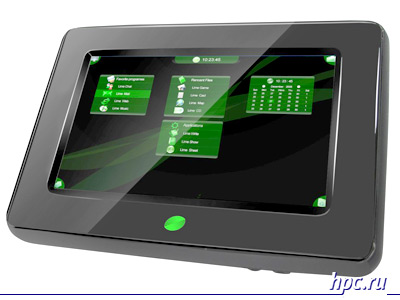 |
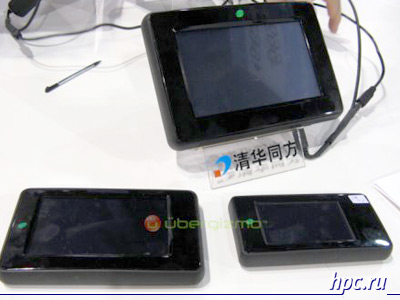 |
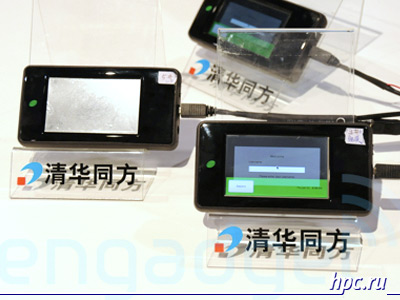 |
The main impression from CES 2008 in terms of mobile innovations can be stated succinctly: "To be continued." We definitely see a lot of interest in a month at the Mobile World Congress. The authors, translation:











